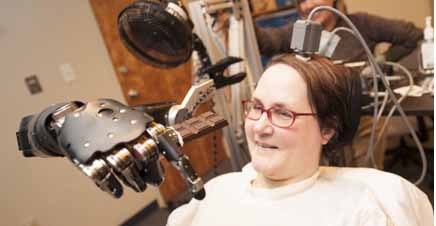
Barbara Crume, PT, ATP
Barbara Crume, PT, ATP, seating and mobility clinic manager, CarePartners Rehabilitation Hospital, Asheville, NC, works primarily with outpatients, helping them choose an optimal wheelchair and equipment to increase their independent functioning and expand their mobility in the home, school, community, and work environments; to enhance their posture; and to guard skin integrity. CarePartners is an 80-bed inpatient rehabilitation facility. Since Crume established the wheelchair clinic in 1993, she has worked with clients who have conditions such as cerebral palsy, paraplegia/quadriplegia, stroke, multiple sclerosis, ALS, and head injuries. After the wheelchair has been fitted, prescribed, authorized, assembled, and delivered, Crume and her colleagues assure that it is a perfect fit.
Judy O’Rourke Has the process changed much since you began your career?
Barbara Crume The technology has improved incredibly over the past 25, 30 years. When I think about the first child I put in a power chair to drive with his head using switches, he actually had to press the switches to make the chair go. Now, the proximity switches don’t require that—there are fiber optics and so many alternative drive controls that have allowed people to continue to be mobile on their own and weren’t available when I first started. I can’t imagine being a new person entering this field. I had a new employee start recently. Orienting him on how to start doing an evaluation made me realize how complicated it all is to someone new. He sat in on some evaluations, and he observed one from the beginning to the end, from first meeting the client to recommending the new chair and all of the components before they left. This took over 3 hours. He’s been a therapist for many, many years, working in all types of settings. He’s new to this specialty. He used to refer people to us, and they got the wheelchair that they needed. But he had no idea of the detail that went into the process.
JO Is 3 hours for one visit the norm?
BC In some clinics, this is the norm, but we have restructured our clinic to have the majority of our visits last 1 to 1.5 hours. However, when somebody travels from 2 hours away, we do schedule 3 hours to reduce their need to travel a second time. Normally, the person comes for the evaluation with the therapist for 1 hour, then they come back for the second visit with the supplier present for another hour to try things. We might need a third visit because we didn’t quite have what we really needed that day or just didn’t have enough time to finish the assessment and spec the chair.
JO In the mix are the patient’s needs/preferences for equipment and options, and your justifications for your scrip?
BC Yes, all of this has to be considered. People have to have a medical need for the equipment, they have to be able to function with that particular chair or component, and it all has to work in their environment.
JO Who is typically on the multidisciplinary team involved in the seating and positioning clinic, and how do you proceed?
BC The primary physical and occupational therapists; case managers; sometimes, for children who are in the school system, we involve their teacher; speech therapist for aud-com access; the employer; whoever works with the person and has anything to do with caring for them; and, of course, the patient—they’re primary. I need their input to make sure we know as much as possible about the patient so we get the right equipment. The patient sees our physical therapist only on the first visit to do the medical intake, start the measurements, and do the mat assessment. The other team members are encouraged to attend the evaluation or send their input to the clinic. Once we determine their possible needs, we then have to decide what supplier they want to work with. We schedule a second visit where the supplier is present and brings a wheelchair set up with seating to further assess the client and determine the final product.
JO Could you describe the clinic—the footprint and the team?
BC Our clinic coordinator does all of our scheduling, obtains prior authorization from the insurance company for the therapy visits, and registers patients upon arrival. We have a rehab associate who assists us in keeping our sample equipment clean and organized; she processes our paperwork to make sure our notes are copied and sent to the correct supplier and referral source, and the originals are sent to medical records. She faxes our treatment plans to the doctors for signature and assists our coordinator in obtaining the signed orders for therapy. We have two evaluation rooms used by myself full time and by two part-time therapists. Each room is equipped with a set of standard and metric tools, a mat table, goniometers and angle finders, a medial lateral stick for measuring the client, and a very heavy-duty, metal, retractable tape measure. We have one mat table that’s a high-low, and one that’s much larger for children and adults who are gravitationally insecure and need to be on a wider surface. We have a cutout on one side of this table for tight hamstrings, so when they sit on the side of the table, their feet can tuck up under the table. If I didn’t have that, a lot of people couldn’t sit on the mat table. We have a seating simulator that we primarily use for custom molding. We have a large room down the hall but within our building, for storage of sample manual and power chairs, and we have a separate seat cushion storage closet and another room for storage of sample back supports, headrests, and other components such as pelvic belts, anterior chest supports, and foot-positioning systems. We try to keep a variety of cross frame and rigid manual wheelchairs and a variety of power bases with different drive wheel positions and power seating systems available for evaluation.
JO At what point in the rehab process does the seating clinic occur?
BC If someone has a new injury, they first go to an acute care hospital, then they come here for their rehab. We start seeing them as soon as it’s identified they’re going to be a long-term wheelchair user or if they have any sign of skin breakdown. They’ll start receiving education by us and their treating therapist about the different chairs, and start getting educated on and trying different cushions either by their PT or in a seating clinic. We pressure map them, especially if they have absent sensation. When a person with a spinal cord injury first comes in, they may still be in a tilt-in-space manual chair or in a manual recliner. By the time they are discharged, we might have them spec’d out to receive an ultra lightweight manual chair.
JO Is there a gap between the client starting rehab and timely receipt of the chair?
BC Yes, it’s often not possible to complete the final recommendations prior to discharge because they still have a body jacket and are not sure what they will need until this is removed. When I first graduated from PT school (in 1982), inpatient rehab for someone with a spinal cord injury was for several months, and now it’s for just a few weeks. So they may have to rent something and come back after they’ve had more therapy at home or as an outpatient, to decide what they want for their final chair. The process is tailored to each individual.
JO Have you tweaked the process to make it run more smoothly?
BC This year, we went through our LEAN events that were a process of organizational revamping. That’s when we changed from trying to “do it all” in one visit to the two-visit process. We met with all of our suppliers and reviewed rules and responsibilities, what we will do, and what we expect of them. We have now made our documentation more streamlined to enter into the computer system and more readable and user-friendly for the suppliers. We expect them to read these reports and come to the second visit and fitting appointments with the chair set up, ready for the client, rather than showing up with boxes of parts that need to be put on. For instance, they should already have the seat depth, footplate height, and back height adjusted to the client’s measurements, and the seat to back angle set up as needed for the individual.
JO What physical aspects do you consider during the patient evaluation, and are long-term considerations integral from day one?
BC We get all of the patient’s information and then decide what we need to address first. If somebody has a pressure sore, then that’s going to be the primary thing I’m going to address. If they’re unable to push a manual wheelchair, I’m going to be looking at whether they’re safe to use power. Depending on their diagnosis, if there’s paralysis with absent sensations, then I’m going to be very concerned about what seating I’m going to recommend, what cushion I’m going to put them on, to prevent them from getting skin breakdown. If it’s a progressive diagnosis, I’m going to make sure we’re thinking ahead. If their condition should change and they become weaker, would the chair modify to accommodate that? We have to think about height and weight; we also ask if there has been a significant change in that height and weight. If somebody weighs 180 pounds before their injury and it’s 6 weeks later and they weigh 150, you’ve got to think, “Are they going to put that weight back on, or will they lose more weight because of their medical condition?” Somebody with ALS may be walking when they come into your clinic, but you want to be working on getting them a power chair, and knowing that down the road they may not be able to operate it with a joystick; you want to make sure the electronics are expandable to allow for the use of alternative drive controls.
JO Are cognitive aspects considered?
BC Cognitive issues are often apparent in our clients. How simple do you keep things? Do you give them four drive modes or just one, because it’s too much for them to cognitively handle? I help very young children obtain power mobility. Cognitively, they may only be ready to drive forward on the first visit. We may not give them access to turn right and left initially. We may just work on stop and go and maintaining pressure on the joystick or the switch. We then add right and left later. I saw one child recently who has cerebral palsy—we explained to him how the proximity switches work, and then put him in a chair with a head array and he was going forward, right, and left all on his own within a few minutes. The problem he was having was stopping, because he was positioned so well in a position he wasn’t used to—sitting upright—he couldn’t get his head down. He was used to hanging out all flexed up in his mom’s arms. When we got him positioned, with his trunk upright and his pelvis upright, he could no longer isolate his head and drop it down into flexion. He cognitively knew what he was supposed to do, and the harder he tried, the more he extended. It’s a motor-learning process.
JO Is there a visual-perceptual component?
BC We have to make sure that clients have full visual field or, if they don’t, that they know how to compensate. If they’ve had a stroke or they have limited peripheral vision, cognitively they need to know to turn their head and look that way—to scan their environment more. We get a sense of their ability to learn and progress. Some clients return to the clinic just to practice with their caregivers until they become more independent with driving. Then we schedule them to return to see the therapist and supplier to complete recommendations and submit for funding.
JO Caregivers often play a significant role?
BC We train the caregivers on how to set the wheelchair up, position the patient, and how to use it. Some of our suppliers have chairs that they set up to go to schools. The school therapist will then work with the child on training the teacher and whoever else is involved with them. The school can get them up to speed, where they can do all the skills they need to do to qualify for funding. Then they’ll return to the clinic and we’ll spec it out.
JO Do you follow up with clients down the road?
BC Once we fit a new wheelchair, we usually do not see the patient again unless they have a problem, condition change, or significant growth. Most of our patients do come back to us for their next wheelchair. I just saw a 29-year-old and a 27-year-old who I treated when they were preschoolers. I’ve learned over the years from things I saw going on with them when they were youngsters and how they turn out as adults. This sometimes makes me wonder what I might have done differently along the way to have prevented some of the problems. Learning what’s important to address—a hip is subluxing, and we keep trying to correct their pelvis position and their trunk, but actually it’s the hip pain that’s been causing the problem. Consulting with their orthopedist to consider doing something sooner rather than later can make a difference long term in their posture and how they develop into adulthood. We often need to accommodate rather than always fully correct their posture.
JO After the wheelchair is delivered, do patients trial it in the clinic?
BC Yes. We see almost all of our patients for fitting and training on the day of delivery in the seating clinic with the supplier. Once the seating is adjusted to fit the patient, we have them drive or propel their chair. Together we program the electronics, and we adjust manual chairs to get the axle position correct, and make sure that every part is set up optimally for them. We tell them to call the supplier if they have a maintenance problem, and to call the therapist if they develop a pressure sore, positioning, balance, or functional issue.
JO Describe medical necessity and writing the scrip.
BC Documentation is quite challenging. We have documentation requirements so we will get reimbursed as a therapist, and documentation requirements for the equipment to be covered by the funding source. It’s somewhat double documentation. Keeping up with all of the regulations of both is very important. If you don’t document the correct diagnosis, if your treatment plan isn’t worded a certain way, if you’re trying to get a K5 chair for somebody and you don’t say why K4 won’t work in your notes—your therapy and/or the wheelchair can be denied. Our documentation system is one that we designed ourselves and includes templated sentences to provide the medical justification for the equipment. This has made the process much faster. As we go over an order form for a wheelchair with the patient and supplier, each optional component selected is noted and the justification entered into our computer program. A lot of treating therapists refer patients to our clinic to get chairs. They don’t keep up with the equipment or the regulations as to who qualifies for what.
JO Securing funding can be challenging?

To read more on this topic, visit “Maximizing Independent Function” and “A Case for Customized Seating.”
BC The funding of equipment is getting tougher and tougher. They’re expecting more for less. The quality of equipment is definitely becoming limited, and what people are able to have access to is limiting their function because Medicare and Medicaid are no longer covering certain items, or you can’t get this with that because of the regulations. It is hurting our clients that they cannot get what they truly need because of regulatory issues. There is work being done on a proposal for a separate benefit category for complex rehab technology (CRT) within the Medicare program. CRT refers to individually configured manual wheelchair systems, power wheelchair systems, adaptive seating systems, alternative positioning systems, and other mobility devices. For more information on this issue, visit the NCART Web site, www.ncart.us. Also, in our area, physicians will not sign paperwork sent directly to them from a supplier for somebody to get a chair. Physicians refer them all through the seating clinic to make sure that not only does a person truly qualify and need it, but they get the right thing the first time. Many times patients have come to us after getting a chair, and it’s inappropriate for them and they’re stuck with it.
Managing editor Judy O’Rourke can be reached at .





